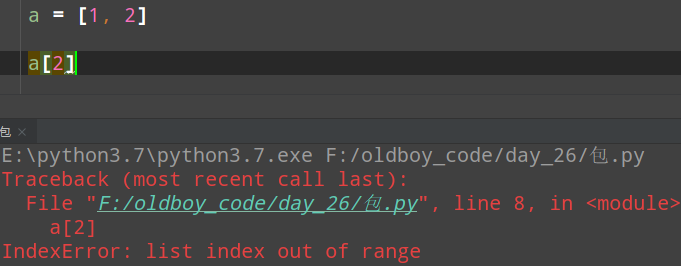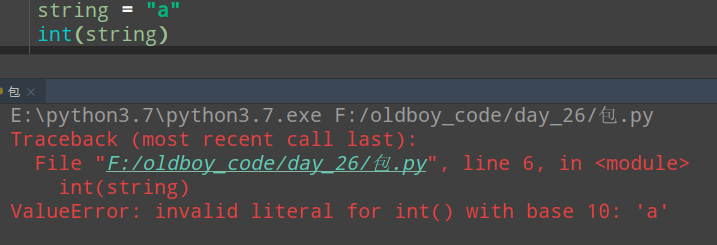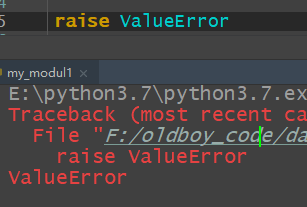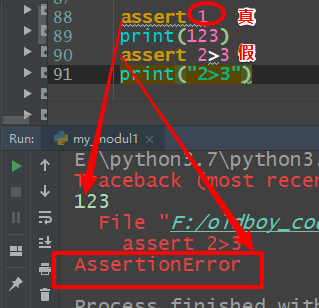abnormal
- Grammatical errors: space indentation grammatical rules
- Logical Error Writing Code Implementation
- Conditional Judgment
- exception handling
Common anomalies
NameError

IndexError

TypeError

ValueError

Common anomalies
AttributeError attempts to access a tree that an object does not have, such as foo.x, but foo has no attribute x IOError input/output exception; basically unable to open file ImportError cannot introduce modules or packages; basically, it's a path problem or a name error Indentation Error grammar error (subclass); code not aligned correctly IndexError subscript index goes beyond the sequence boundary, for example, when x has only three elements and tries to access x[5] KeyError attempts to access keys that do not exist in the dictionary Keyboard Interrupt Ctrl + C is pressed NameError uses a variable that has not been assigned to an object SyntaxError Python code is illegal and cannot be compiled. TypeError incoming object type does not meet requirements UnboundLocalError attempts to access a local variable that has not yet been set, basically because there is another global variable with the same name. Cause you think you're visiting it. ValueError passes in a value that the caller does not expect, even if the value type is correct
More anomalies
ArithmeticError AssertionError AttributeError BaseException BufferError BytesWarning DeprecationWarning EnvironmentError EOFError Exception FloatingPointError FutureWarning GeneratorExit ImportError ImportWarning IndentationError IndexError IOError KeyboardInterrupt KeyError LookupError MemoryError NameError NotImplementedError OSError OverflowError PendingDeprecationWarning ReferenceError RuntimeError RuntimeWarning StandardError StopIteration SyntaxError SyntaxWarning SystemError SystemExit TabError TypeError UnboundLocalError UnicodeDecodeError UnicodeEncodeError UnicodeError UnicodeTranslateError UnicodeWarning UserWarning ValueError Warning ZeroDivisionError
What is an exception?
When a program error occurs, the later code of the wrong program will not be executed.
What is exception handling?
It is designed to catch this exception (this code has nothing to do with program logic, but with exception handling). If it catches successfully, it enters another processing branch and executes the logic you customized for it so that the program does not crash. This is exception handling.
Why exception handling?
When a python parser detects an error, it triggers an exception. When the exception is triggered and not processed, the program terminates at the current exception. The code behind it will not run. Who will use a software that runs suddenly and crashes?
So you have to provide an exception handling mechanism to enhance the robustness and fault tolerance of your program.
Basic grammar for exception handling
Single branch
try:
Code blocks detected
Exceept except ion type:
Once an exception is detected in try, the logic for this location is executedtest
try:
f = open('test', 'r')
lines = (line.strip() for line in f)
print(lines.__next__())
print(lines.__next__())
print(lines.__next__())
print(lines.__next__())
print(lines.__next__())
except StopIteration:
print("Ha-ha!")
#*********************************************
l = ['apple', 'banana', 'umbrella']
for num, goods in enumerate(l, 1):
print(num, goods)
try:
choose = int(input('Please enter the serial number of the goods you want to choose. :'))
print(l[choose - 1])
except ValueError:
print('Please enter a number.')
Multi-branch structure:
try:
Code blocks detected
Exceept except ion type:
Once an exception is detected in try, the logic for this location is executed
Exceept except ion type:
Once an exception is detected in try, the logic for this location is executed
Exceept except ion type:
Once an exception is detected in try, the logic for this location is executed
...test
l = ['apple','banana','umbrella']
for num,goods in enumerate(l,1):
print(num,goods)
try:
choose = int(input('Please enter the serial number of the goods you want to choose. :'))
print(l[choose-1])
except ValueError:
print('Please enter a number.')
except IndexError:
print('The serial number you entered is not in the list of goods.')
l = ['apple', 'banana', 'umbrella']
for num, goods in enumerate(l, 1):
print(num, goods)
try:
choose = int(input('Please enter the serial number of the goods you want to choose. :'))
print(l[choose - 1])
except (ValueError, IndexError):
print('Please enter the correct and valid serial number.')
except NameError:
print('One happened. name error')Omnipotent anomaly
Almost all anomalies can be captured by omnipotent anomalies
try:
Code blocks detected
except Exception:
Once an exception is detected in try, the logic for this location is executed
# Or
try:
Code blocks detected
except:
Once an exception is detected in try, the logic for this location is executed
# But this is usually the case:
try:
Code blocks detected
except Exception as e:
Once an exception is detected in try, the logic for this location is executedtest
try:
a
[][1]
{}['key']
1/0
import aaa
except :
print("No mistakes")
# **********************************************
try:
a
[][1]
{}['key']
1/0
import aaa
except Exception :
print("No mistakes")
#*********************************************
try:
a
[][1]
{}['key']
1/0
import aaa
except Exception as e :
print(e)
print("No mistakes")
Note: try not to use the omnipotent exception, if you use, must write as
Multi-branch and omnipotent anomaly
l = ['apple', 'banana', 'umbrella']
for num, goods in enumerate(l, 1):
print(num, goods)
try:
choose = int(input('Please enter the serial number of the goods you want to choose. :'))
print(l[choose - 1])
except (ValueError, IndexError):
print('Please enter the correct and valid serial number.')
except Exception as e:
print(e)
Note: Exception Universal Exceptions are always at the end of all except branches
summary
Single branch
try:
Code that may have exceptions
Exceept error type:
Handling exceptions
Multi-branch
try:
Code that may have exceptions
Exceept error type 1:
Handling exceptions
Exceept error type 2:
Handling exceptions
try:
Code that may have exceptions
except (Error Type 1, Error Type 2...):
Handling exceptions
Omnipotent anomaly
try:
Code that may have exceptions
except Exception as e:
Handle exceptions and print or record e
Omnipotent anomaly and multi-branch
try:
Code that may have exceptions
Exceept error type 1:
Handling exceptions
Exceept error type 2:
Handling exceptions
except Exception as e:
Handle exceptions and print or record eExtended grammar of exception handling
try:
Code that may have exceptions
except (Error Type 1, Error Type 2...):
Handling exceptions
else:
passtest
l = ['apple','banana','umbrella']
for num,goods in enumerate(l,1):
print(num,goods)
try:
choose = int(input('Please enter the serial number of the goods you want to choose. :'))
print(l[choose-1])
except (ValueError,IndexError) as e1:
print(e1)
print('Please enter a normal serial number.')
except Exception as e2:
print(e2)
else:
print('Execute me')The above code: If there are no errors in the code block below try, the statement below else will be executed, and if there are errors in the code block below try, the corresponding exception statement will be executed.
Why not put the statement under else at the bottom of try's block? Look at the following code:
try:
choose = int(input('Please enter the serial number of the goods you want to choose. :'))
print(l[choose-1])
print('Execute me')
except (ValueError,IndexError) as e1:
print(e1)
print('Please enter a normal serial number.')
except Exception as e2:
print(e2)
If the code under else is placed under try, it can be said that the code is protected. When there are errors in the code under else, the corresponding exception handling will be performed. If there are no errors, it will be placed under try and under el, which is no difference at first sight.
finally
try:
pass
except Error type 1:
pass
except Error type 2:
pass
...
finally:
pass
test
l = ['apple', 'banana', 'umbrella']
for num, goods in enumerate(l, 1):
print(num, goods)
try:
choose = int(input('Please enter the serial number of the goods you want to choose. :'))
print(l[choose - 1])
except (ValueError, IndexError) as e1:
print(e1)
print('Please enter a normal serial number.')
except Exception as e2:
print(e2)
finally:
print('Execute me')
# **********************************************
def func(filename):
try:
f = open(filename,'r')
content = f.read()
return content
except Exception as e:
print(e)
finally: # Execute it anyway
f.close()
print('It must be carried out.')
ret = func('test')
print(ret)
def wrapper(func):
def inner(*args,**kwargs):
try:
print('before func')
return func(*args,**kwargs)
finally:
print('after func')
return inner
try:
f = open('test')
for line in f:
a,b = line.strip().split(',')
finally:
f.close()
print('Execute me')
summary
- Other: If there are no errors in the try code, execute it
- finally: Must be implemented
- Execute the code in final before encountering return
- Encountering an error also executes the code in final before the end of the program
Exception handling structure:
# try except # try except except # try except ... else # try except ... else finally # try except ... finally # try finally
Custom exception
class My_abnormal(Exception):
def __init__(self, msg):
self.msg = msg
super().__init__()
def __str__(self):
return "abnormal{}".format(self.msg) # Must be return or error will be reported
my_error = My_abnormal("NameError")
print(my_error)class Empty(Exception):
def __init__(self,msg):
self.msg = msg
super().__init__()
def __str__(self):
return self.msg
class class:
def __init__(self):
self.students = ['Tom']
def get(self):
if not self.students:
raise Empty('The student list is empty')
else:
return self.students.pop()
clas = class()
stu1 = clas.get()
print(stu1)
stu2 = clas.get()
print(stu2)throw
# exception types thrown by raise

Assertion
assert Boolean value # If true, the following code is executed smoothly # If false, throw an exception
